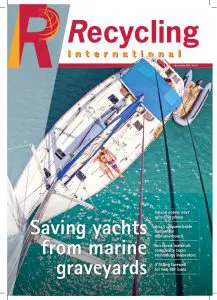Page 44 from: December 2015

42 December 2015
M A R K E T A N A L Y S I S
Paper
Closed: November 24, 2015
US mill buying prices
tumble in November
Reports from the USA indicate
sluggish export demand for fibre
despite historically low ocean
shipping rates. On the upside,
European exporters confirm
that Indonesian buyers have
made a return to the market,
although not for substantial
tonnages as yet. Fibre demand
has remained healthy within
Europe itself.
Europe
Chinese demand stable
With good demand, most European
mills have kept their lower grade
prices stable in November while
recovered paper processing facilities
have reported reasonable volumes of
incoming material. For the Far East,
OCC prices have stabilised while the
US dollar and freight rates have even
made small increases possible. Indo-
nesian buyers have returned to the
market – but not yet for high volumes
– while demand from China has been
stable.
Demand for the deinking and middle
grades of recovered paper has been
very good in Europe, although prices for
some of the latter qualities have fallen
around Euro 5 per tonne in November.
There has also been some demand
from Asia for the deinking and middle
grades, but at slightly lower price levels.
For the high grades, prices have been
stable and demand good for the limited
volumes available.
Latest data suggest that utilisation of
paper for recycling will drop 0.7% this
year to 47.2 million tonnes across the
18 member countries (17 EU states plus
Norway) of the Confederation of Euro-
pean Paper Industries (CEPI). However,
this total is 1% higher than the figure
for 2005 despite a drop in paper and
board production of 7.6% when com-
pared to a decade ago.
North America
Mill stocks at high level
In the USA, mill buying prices for brown
and office paper grades have continued
to tumble in November. According to
The Paper Stock Report’s survey of buy-
ers and sellers, the average domestic
mill buying price for 17 commonly-
traded grades fell to its lowest mark
since March this year – a number that
hadn’t previously been seen since Sep-
tember 2012.
Deinking grades like sorted office paper
(SOP) have been particularly weak.
November’s national average SOP mill
buying price of US$ 137 per ton marked
a 9% drop compared to October and
was 13% below the year-earlier price.
Meanwhile, the brown grades have
continued to inch downwards.
According to traders, recovered paper
inventories are high at paper and board
mills and demand is lacklustre moving
DS Smith wins Zero Waste award for difficult-to-recycle materials
Leading recovered fibre consumer DS
Smith has won the Achieving Zero
Waste award from the UK Chartered
Institution of Wastes Management
(CIWM) for the Reject Processing
Centre (RPC) at its 800 000-tonnes-
per-year Kemsley paper mill in south-
east England. Presented last month
in London, the accolade formed part
of CIWM’s 2015 Sustainability and
Resource Awards.
The centre at Kemsley was estab-
lished to find the best approach for
waste arising from the processing
and production of paper and card-
board. ‘The waste generated and sub-
sequently used in the RPC amounted
to 12 000 tonnes per annum of
ragger – a byproduct of the paper
pulping process containing baling
wire, plastics and fibre – and 29 000
tonnes per annum of light rejects,’
the company explains. In a six-month
period, a total of 12 400 tonnes was
diverted from landfill.
Machinery and equipment were
tested with nearby Countrystyle
Recycling. A single-shaft, heavy-
duty shredder was fitted to separate
out the wire, plastic and wet fibrous
material (WFM) from the ragger. The
wire is sent for recycling and thus
becomes ‘a revenue earner’ rather
than a cost, generating £20 000 (US$
30 000) in a single month. Plastics
with little value are diverted into DS
Smith’s onsite waste-to-energy plant
to be turned into fuel; remaining
plastics are mixed with sludge from
the mill effluent process and used to
process steam used back in paper
production. ‘The remaining fibres
(WFM) go back into the mill paper
process to be reused as good fibre,’
DS Smith points out. ‘This amounts to
75% of all WFM output.’
Head of recycling Dr Jim Malone com-
ments: ‘A zero-waste philosophy is
central to the work at DS Smith and,
as a company, 100% of collected
resources are turned back into some-
thing useful. The Reject Processing
Centre demonstrates that we are
delivering on our aims and closing
the loop on as many materials as
possible.’



